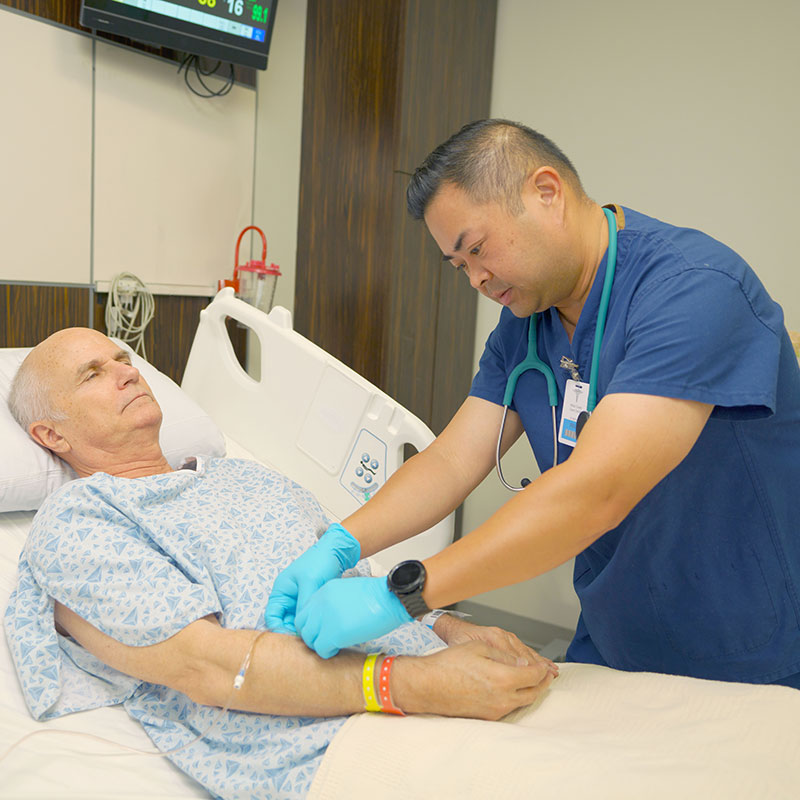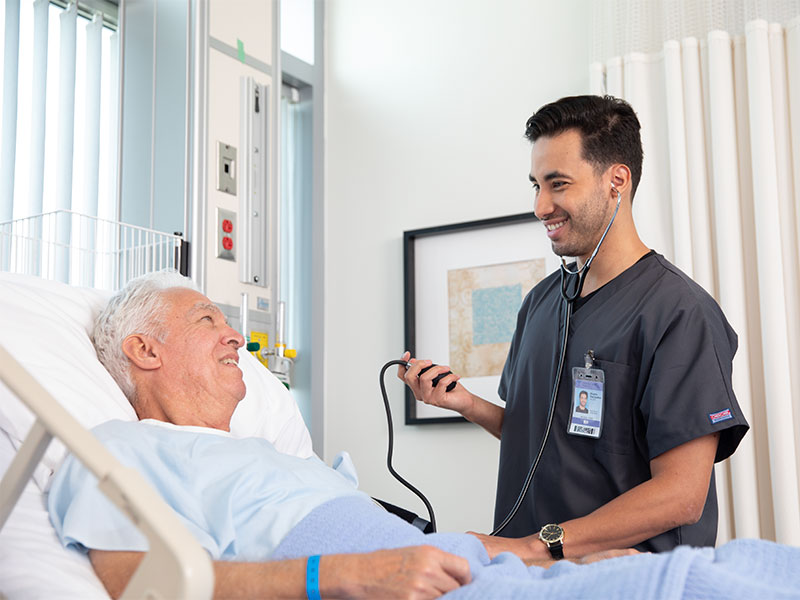How to Become an Adult-Gerontology Acute Care Nurse Practitioner in California


California’s population is aging. The number of Californians age 65 and older is projected to grow by 59% by 2040, with the most dramatic growth occurring among Californians age 80 and older, an age group that is expected to double by 2040, according to the Public Policy Institute of California. With the rapid growth of this demographic comes rising demand for healthcare services, including acute care.
So, if you’re thinking of becoming an adult-gerontology acute care nurse practitioner (AGACNP), you’re starting at a time when your services are greatly needed. In this career guide, we will explore what an AGACNP career looks like and the steps for becoming this type of nurse practitioner in California.
What Does an AGACNP Do?

As an adult-gerontology acute care nurse practitioner, you will treat complex and acute health conditions in older patients. In addition to treating and managing serious and chronic conditions, this role also focuses on disease prevention and taking steps to avoid future complications so you can help keep your patients in optimal health.
AGACNPs commonly work in hospital inpatient settings such as intensive care, trauma, and acute care units, as well as outpatient settings such as specialty clinics. These kinds of nurse practitioners may also work in long-term care facilities. Additionally, some AGACNPs roles may incorporate non-clinical work, including research, administrative, or teaching responsibilities, according to the American Association of Nurse Practitioners (AANP).
It’s also important to note that it’s common for adult-gerontology acute care nurse practitioners to work non-traditional hours, as they are often needed for night and weekend shifts.
How Much Autonomy Does an AGACNP Have in CA?
Nurse practitioners have a broader scope of practice than registered nurses, such as through the ability to examine patients, diagnose illnesses and injuries, and prescribe medications and treatments. However, the level of autonomy for this role varies state by state.
Previously, California was among the states with restricted practice for NPs, meaning nurse practitioners had to collaborate with and work under the supervision of a physician for certain activities — but that is changing with the passage of new legislation (2020) that allows nurse practitioners to obtain full practice authority once they meet certain requirements. This means NPs can work independently within the population focus of their national certification.
Now that you have a better understanding of what it’s like to work as an AGACNP, it’s time to review the steps to becoming this type of nursing professional.
Step 1: Become a Licensed RN

The first thing you must do is become licensed as a registered nurse through the California Board of Registered Nursing (BRN). This requires you to:
- Complete an associate degree in nursing (ADN) or a Bachelor of Science in Nursing (BSN)
- Pass the National Council Licensure Examination for registered nurses (NCLEX-RN)
- Apply for your California RN license through the BreEZe platform
Learn the full steps for becoming an RN in California.
Step 2: Gain Experience Working as an RN
Adult-gerontology acute care nursing programs require applicants to have direct patient care experience within acute care settings. For example, West Coast University requires applicants to its Master of Science in Nursing – AGACNP program to have at least one year of experience working as an RN in an intensive care unit (ICU) within the past five years.
This professional experience can help lay the groundwork for your post-graduate studies and help you better understand the day-to-day nature of the job as an AGACNP.

Step 3: Earn an Advanced Degree or Certificate
Once you’re a licensed RN and you have the necessary experience, you can apply for a post-graduate AGACNP program. This will typically be a Master of Science in Nursing (MSN) with a specialized focus in adult-gerontology acute care, and your studies should include both traditional coursework and hands-on training in healthcare settings. Some institutions (like WCU) offer an RN to MSN – AGACNP program, which allows you to leverage your professional nursing experience toward both a bachelor’s and master’s degree through a single program.
Additionally, if you’re an RN who already has a master’s degree in another field, you can complete a post-master’s certificate program in adult-gerontology acute care nursing.
Your expected program completion time will depend on the type of program you choose and your program pace (i.e., full-time versus part-time). Below are the timelines for West Coast University’s AGACNP programs:
- Accelerated pace: 20 months
- Working Professional pace: 32 months
- Accelerated pace: 28 months
- Working Professional pace: 44 months
Post-Master’s Certificate – AGACNP Program
- Accelerated pace: 16 months
Note that all nursing programs offered at WCU are nationally accredited and to become nationally certified as an AGACNP (covered in the next section), you will need to graduate from a program that is accredited by a national nursing accreditor (CCNE, ACEN, or NLN CNEA).
Step 4: Pass the AGACNP National Board Certification Exam

After earning your master’s degree or post-master’s certificate, you will need to pass the Adult-Gerontology Acute Care Nurse Practitioner board certification exam, which is offered through the American Nurses Credentialing Center (ANCC) or American Association of Critical Care Nurses (AACN). During the exam, you will have up to 3.5 hours to answer 175 questions.
To apply to sit for the national certification exam, you will need to provide certain documentation, including your online application, your Validation of Education (VOE) form, clinical hour documentation, and your transcripts. Learn more about the exam and process on the certification FAQ page.
Step 5: Obtain Your California Nurse Practitioner Certification
Next you must apply for your California nurse practitioner certification. This will involve:
- Completion of your application through the BreEZe platform
- An education verification form submitted by your academic program
- An official, sealed transcript showing your date of graduation
If your program is not CA board-approved, you may need to have a nurse practitioner and/or physician submit verification of your clinical competency and provide additional information about your program and coursework. View the full instructions for applying for an NP certification in California.
Step 6: Renew Your Licenses and Certifications As Needed

To continue working as an AGACNP without interruption, you will have to keep the following licenses and certifications active:
- California RN license (renew every two years)
- California NP certification (renew every two years)
- National ACACNP board certification (renew every five years)
To renew, you typically need to take steps like paying a fee, completing a certain number of continuing education hours, and reporting any disciplinary action or convictions.
Start Your Educational Journey Today
If you’re passionate about helping adult and geriatric patients improve their health and longevity, now is the time to pursue your goal of becoming an AGACNP. Take the first step by applying to an academic program that aligns with your career objectives.
Whether you need to complete your bachelor’s degree before advancing to an MSN or are seeking to fill requirements in post- graduate education, West Coast University offers programs designed to help support your success.
Learn more about West Coast University’s MSN, RN to MSN, and post-graduate certificate programs specializing in adult-gerontology acute care.
Request Info
- Flexible online and campus programs
- 65,000 alumni across the globe
- Experienced faculty and staff